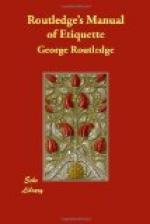It is very difficult, we might say impossible, to give any definite rules about dress. Fashions change so continually, that if we were to write a dissertation upon peplums, and trains, and gores, or give directions how to cut them out or make them, almost by the time this manual should come into circulation, they would have become portions of the past, and our hints would seem absurd and out of place. All that has seemed feasible to us we have done, which has been to give certain hints that the rocks upon which so many split, who make great endeavours to be well dressed, might be avoided by our readers.
There is no doubt that every one wishes to dress well, whatever her means may be; and that no one thinks she dresses ill, whatever the world may think of her performance. We look at ourselves through coloured glass, and are apt to take the most favourable view of our own peculiarities—
“O, wad some power the
giftie gie us,
To see ourselves as others
see us.”
There are rules in dress, as there are in painting, which, if observed, will prevent our making “frights” of ourselves. Anyone who starts for herself on a new line, and, throwing to the wind the received laws, adopts and carries out some crude theory of her own, however much she may entertain herself by her experiments, runs a great chance of making a figure of herself, and will infallibly obtain a reputation for conceit and affectation. No woman, unless she is a star of great magnitude, or a belle of note, can with impunity set at nought the received customs. She is by no means bound to follow fashion so implicitly and subserviently as to mar her own beauty. But a clever woman will always be able to avoid affronting fashion while she takes a line of her own. We use this phrase with a certain limitation, because if a woman were to take a line of her own unrestricted by certain “convenances” of society and of fashion, she would certainly fall into the very error which we should be the first to declaim against, namely—the error of eccentricity. A due regard for these “convenances” will ensure that sense of propriety in dress which will make everyone remember both her station and her means. The fine lady will not effect the simplicity of the village girl, nor the village girl aspire to be mistaken for the fine lady. Both will maintain their own positions, and will be respected while they maintain them.
Let it also be borne in mind that a bonnet or cap, mantle or gown, may be very pretty in itself and very becoming to some persons, but not necessarily to everyone; generally to only a few. The young and the old have each their privileges. The one must not dress like the other. Though we have seen some who have been foolish enough to forget the years that have passed, and cannot realise the fact that they are no longer young, and vie with the youngest in the youthfulness of their attire, we do not, we admit, often find the young endeavouring to make themselves look older than they are. One who has thought much and written well on this subject says, “Doubtless if there were any way of making old people young, either in looks or anything else, it would be a delightful invention; but meanwhile juvenile dressing is the last road we should recommend them to take.”




